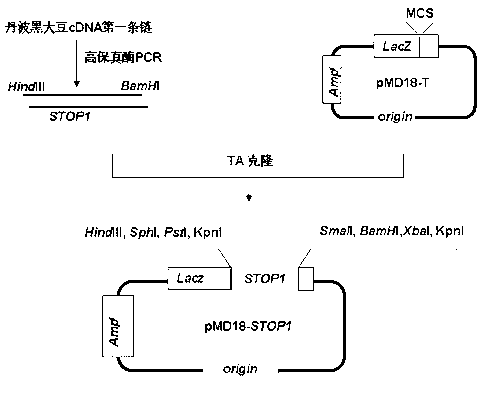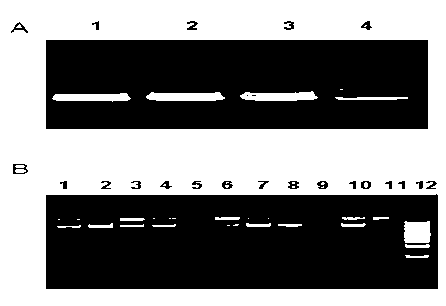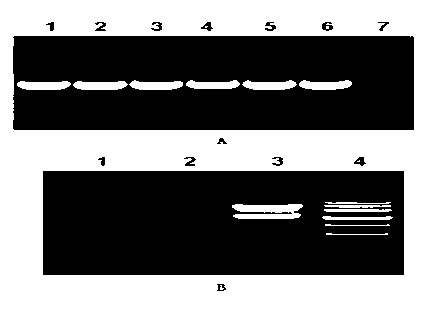Plant expression vector of Tanba black soybean C2H2 zinc finger protein gene STOP1 and application thereof
A plant expression vector and zinc finger protein technology, applied in the field of plant genetic engineering, to achieve the effect of enhancing the secretion of malic acid and citric acid
- Summary
- Abstract
- Description
- Claims
- Application Information
AI Technical Summary
Problems solved by technology
Method used
Image
Examples
Embodiment 1
[0034] Example 1: STOP1 Gene cDNA amplification, TA cloning and sequence analysis
[0035] According to NCBI GmSTOP1 The published ORF sequence, the designed primers are:
[0036] Upstream primer: 5′- GGTACC ATGTTGAATAACCTTTCCTTCC-3′
[0037] Downstream primer: 5′- GGTACC GATAGCGACAATTTATAA-3′
[0038] Add the GGTACC characteristic sequence to the 5' end and 3' end of the upstream primer, and thus form Kpn The I enzyme cutting site is amplified with the first-strand cDNA of Danbo black soybean as a template to obtain STOP1 The full-length cDNA of the gene;
[0039] After aluminum-resistant soybean variety Danba black soybeans were treated with aluminum for 24 hours, cut 0.1g of roots, grind them with liquid nitrogen, add 1ml of TRIzoL extract, let stand at room temperature for 5min, then transfer to a centrifuge tube, then add 0.2ml of chloroform, shake and mix well , centrifuge for 15min (12000rpm), transfer the supernatant to a new tube, add 0.5ml of isopropano...
Embodiment 2
[0042] Example 2: Construction of plant expression vector pPZP-35S- STOP1
[0043] use KpnI pMD18- STOP1 and pPZP-221 vector ( Figure 5 A), the excised vector and insert fragments were separated by agarose gel electrophoresis, and pMD18- STOP1 produced after being cut STOP1 The gene fragment (about 1.2kb) and the linear vector fragment pPZP-221 generated after pPZP-221 were cut, and then pPZP-221 and STOP1 The DNA fragment of the gene produces the plant expression vector pPZP-35S- STOP1 ( Figure 4 ). Conversion of high efficiency (10 8 ) Escherichia coli competent cells (DH5α, purchased from Tiangen Biochemical Technology Co., Ltd.), spread the transformed Escherichia coli on a plate added with spectinomycin (Spe, 50 μg / ml), cultivate overnight at 37 °C, and screen Spe-resistant recombinant colonies. Plasmids were extracted from Spe-resistant recombinant colonies for PCR detection ( Figure 5 B). use KpnI Enzyme digestion detection of pPZP-35S- STOP1 , two ...
Embodiment 3
[0044] Embodiment 3: use STOP1 Agrobacterium
[0045] Competent cells of Agrobacterium were prepared, and the above-constructed plant expression vector pPZP-35S- STOP1 Transform into Agrobacterium (C58Cl(pPMP90)), and select transformants on plates added with spectinomycin. Take a small amount of plasmid and add it to the competent cells of Agrobacterium, mix gently; add the mixture into the pre-cooled electroporation cup, tap the cup body gently to make the mixture fall to the bottom of the cup; place the electroporation cup on the electroporation In the chute of the BIO-RAD instrument, use a 1mm electric shock cup and 200 ohm, 2.5kV / 0.2cm parameters for electric shock, take out the electric conversion cup immediately after the electric shock, quickly add 0.5 ml SOC medium, mix well, and transfer to In a 1.5ml centrifuge tube; 28°C, 200rpm shaker culture for 3-5h; room temperature, 7500rpm centrifuge 1min, discard most of the supernatant, retain 100μl to suspend the cells; ...
PUM
 Login to View More
Login to View More Abstract
Description
Claims
Application Information
 Login to View More
Login to View More - R&D
- Intellectual Property
- Life Sciences
- Materials
- Tech Scout
- Unparalleled Data Quality
- Higher Quality Content
- 60% Fewer Hallucinations
Browse by: Latest US Patents, China's latest patents, Technical Efficacy Thesaurus, Application Domain, Technology Topic, Popular Technical Reports.
© 2025 PatSnap. All rights reserved.Legal|Privacy policy|Modern Slavery Act Transparency Statement|Sitemap|About US| Contact US: help@patsnap.com



